Technology has rapidly become the beacon of hope and progress for healthcare; it has helped promote remote patient care and improve medical outcomes, and it is evolving to keep healthcare apps innovative and relevant.
It’s undeniable: technology has woven itself into the very fabric of our existence. It quickly went from being an unattainable luxury accessible only to scientists and millionaires to becoming the epicenter of progress and innovation. It is now the driving force behind the reshaping of countless sectors, from business to entertainment, and how we communicate, work, and live. In other words, technology has stopped being a tool and is now a necessity; it’s the guiding light illuminating our path toward the future. This statement is particularly true for industries like finance and healthcare, where technology stands as a driving force behind innovation efficiency, and in the latter, it is even helping save lives, which brings us to the central premise of this article.
In the bustling heart of the digital age, the healthcare landscape is evolving at neck-breaking speeds. As a result, there has been a fusion between healthcare and technology, which has brought about groundbreaking innovations that are not just transforming the industry but also profoundly impacting patients’ lives. This synergy between healthcare and technology has ushered in a new era, making healthcare services much more accessible, efficient, and personalized. But how? What exactly are the tech innovations that are reshaping remote patient care? Let’s find out!
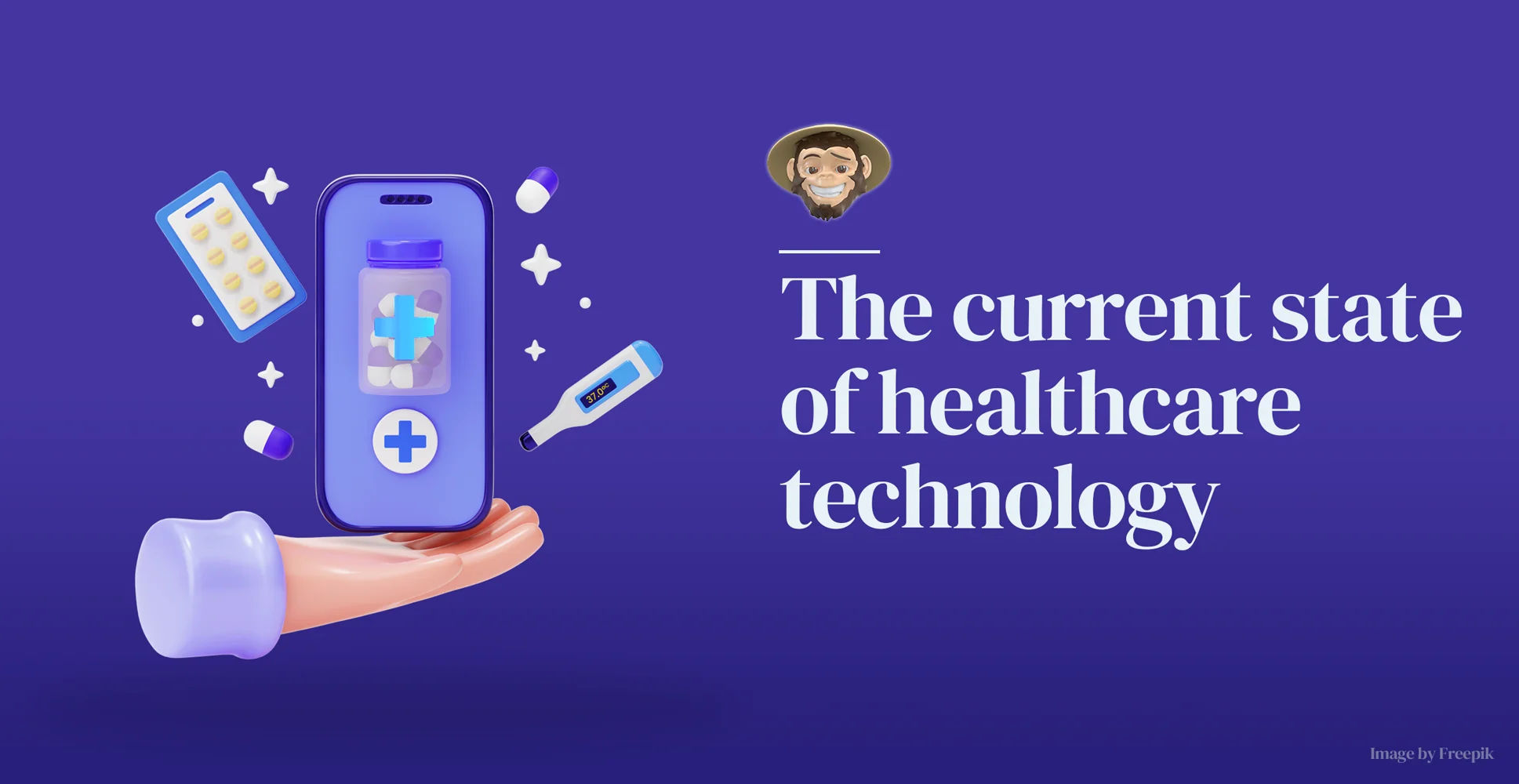
The current state of healthcare technology
One of the most significant advancements in the medical field in recent years has been the integration of technology into remote patient care and healthcare apps. And lucky us because who likes dealing with long waiting lines, full hospitals, stacks of paperwork, and all the red tape that usually comes with in-person medical care? No one. Medical professionals, governments, and other stakeholders are taking the leap toward and striving to bring medical care into the digital realm and make it more accessible. In fact, according to research, globally, healthcare information systems will be worth $287.8 billion by the end of 2022, a number that should reach a colossal $528.5 billion by 2030. What’s more, tech-powered diagnostics and equipment have helped improve medical care delivery with a 70% improvement in the survival rates of heart attack patients and reduced mortality rates for those fighting cancer!
But the good news doesn’t end there. From dental care to fitness, there are currently countless new tech-powered healthcare products and systems hitting the market that are making remote patient care a walk in the park. For instance, the global home healthcare market size will likely reach a whopping $700 billion by 2030, meaning that healthcare isn’t just at the hands of medical professionals or accessible via in-person visits anymore; it’s knocking at our doors and actually making a positive impact in our lives and healthcare systems across the globe.
Tech innovations that are helping improve remote patient care
So, looking through the lens of the transformative alliance between healthcare and technology, we can begin to discuss which are the tech innovations that are reshaping the way patients receive care. These technological advancements are also helping us build a sustainable healthcare landscape where remote patient care solutions are becoming powerful tools in the hands of both patients and healthcare providers.
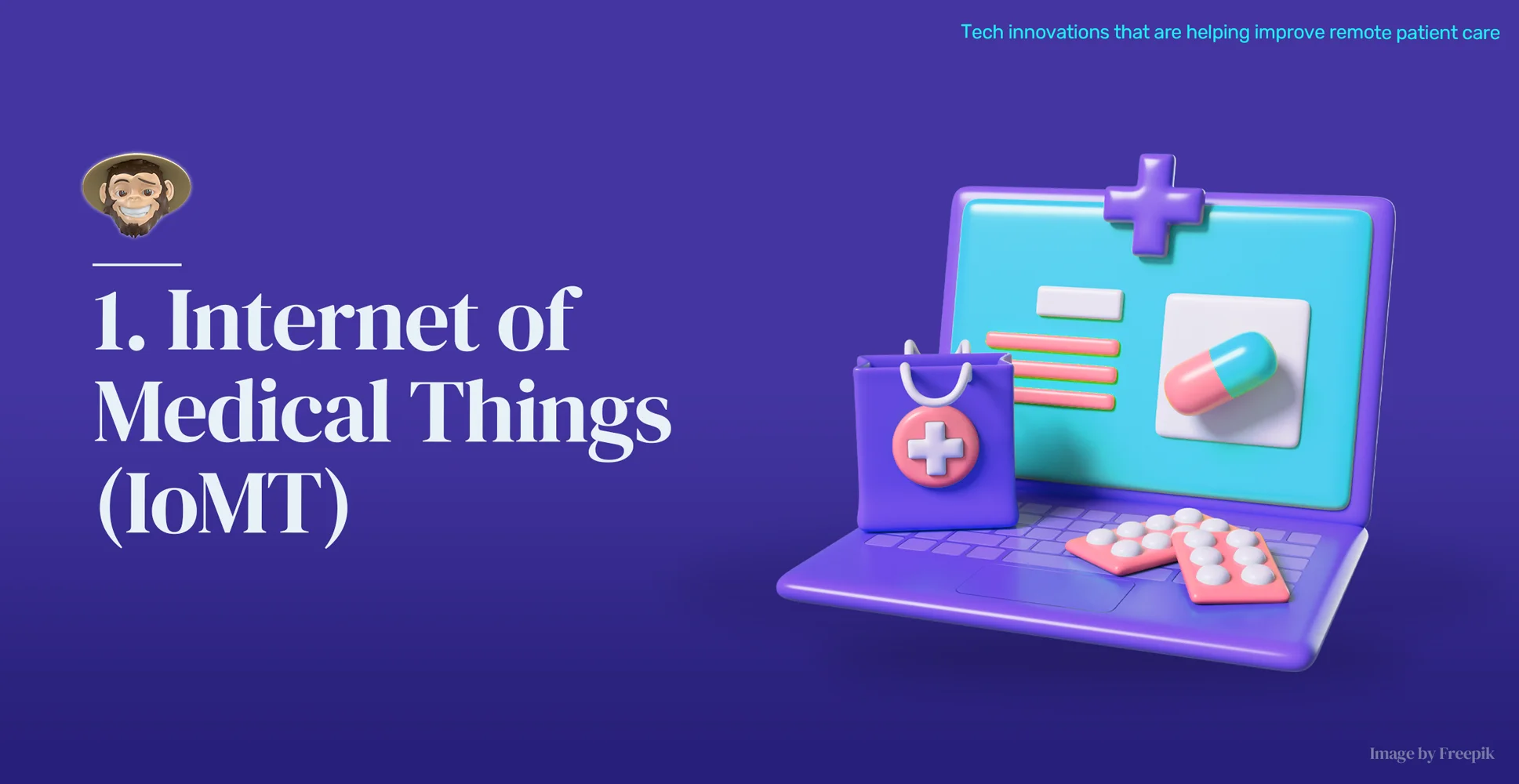
1. Internet of Medical Things (IoMT)
You’ve probably already heard the term Internet of Things (IoT) and have some idea of what it is. But what about the Internet of Medical Things? Originally, IoMT was a simple by-product of the IoT cosmos. However, it now stands out as a revolutionary concept and has now become a valuable ally for healthcare institutions worldwide. What separates the IoMT concept from other IoT ecosystems is the marriage between the wave of internet-connected medical devices and the systems and software that gather data from those devices. In other words, IoMT creates a durable bond between stakeholders, data, processes, and devices. This bond drives medical care delivery and improves patient outcomes without raising workloads or adding pressure to the healthcare system. When we add healthcare apps to the mix, we transfer those relationships to the mobile arena. This enables remote access to patient data, real-time device data monitoring, telehealth services, consultations, education, and much more.
Currently, the IoMT ecosystem offers various services that range from wearable fitness trackers that help users exercise to specialized medical sensors that provide real-time health data and allow physicians to monitor their patients remotely. These sensors are becoming much smaller and more efficient. They are usually simple smartwatches or patches that collect and transfer health data related to blood pressure, heart rate, oxygen and blood glucose levels, weight, temperature, activity levels, and electrocardiograms. As a result, healthcare providers can access data regarding a patient’s vital signs, activity levels, and other critical health metrics without the need for in-person visits, saving valuable resources and paving the way for significant advancements, especially in the realm of remote patient monitoring.
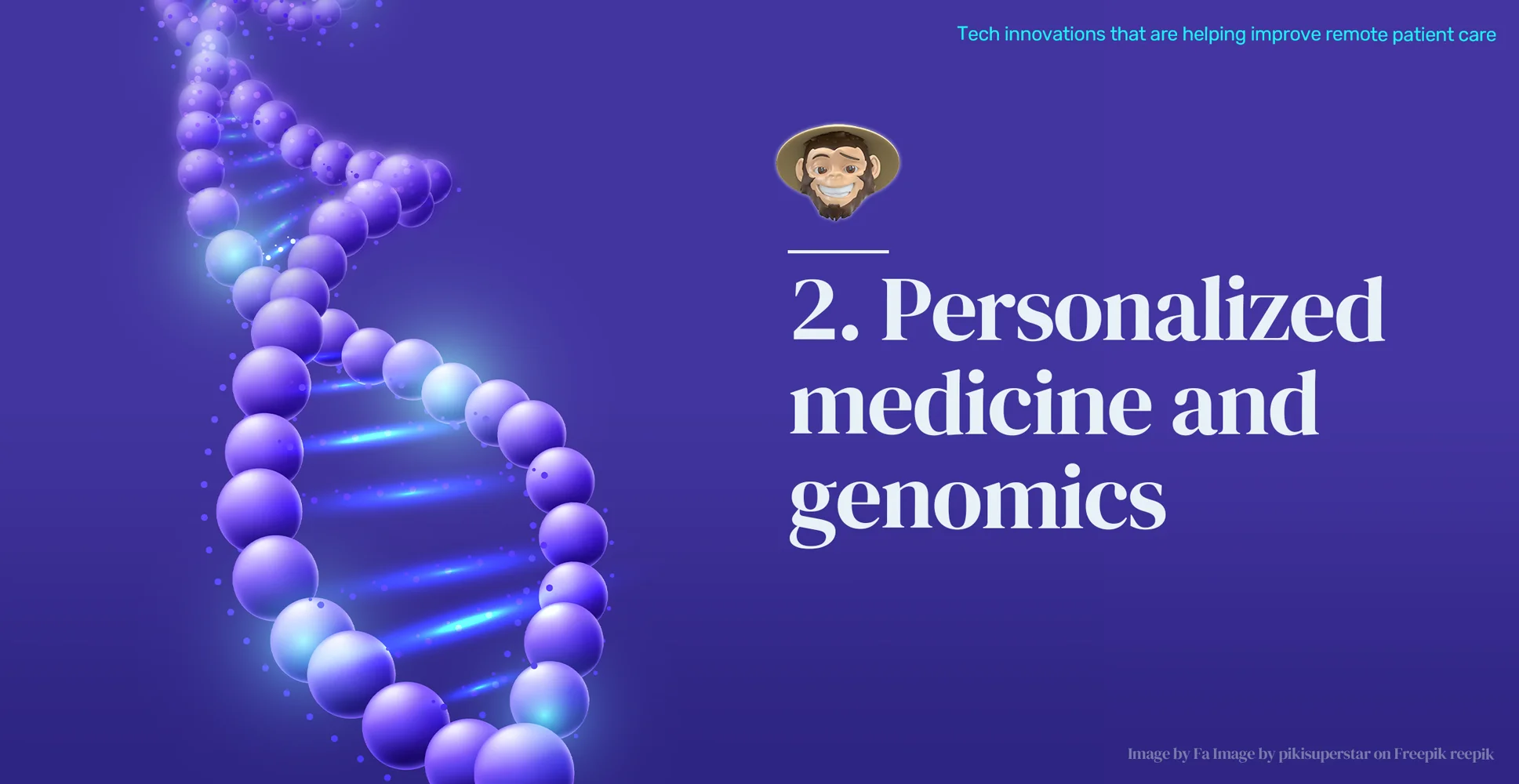
2. Personalized medicine and genomics
Personalized medicine has become critical in improving remote patient care, and that’s primarily due to the introduction of genomics into the realm of remote medical care. After all, what’s more personalized and unique than our genetic composition? The substance behind using genomics in remote patient care lies in tailoring medical treatments to each user’s individual needs, conditions, and general characteristics. It involves analyzing a patient’s DNA to guide medical decision-making. It includes using genetic data to predict disease-related genetic markers and risk factors, tailor medical treatments, and create predictions to pinpoint solutions that allow physicians to build preventive measures for high-risk patients.
In the past few years, genomics has contributed to significant advancements in the field of personalized medicine. Still, it has also helped in the understanding of countless genetic diseases and the study of each individual’s genetic makeup to predict future illnesses and know how they will respond to certain medications. This knowledge is particularly valuable for remote patient care because it allows physicians to leverage healthcare platforms to integrate the genetic data of their patients with other health metrics for continuous monitoring. Moreover, it allows physicians to implement precision medicine, enabling the development of targeted therapies that are invaluable for identifying predispositions to certain diseases and implementing early detection and intervention.
As you can see, personalized medicine and genomics provide a holistic approach that allows physicians and other stakeholders to reach a more in-depth understanding of a patient’s health without the need for lengthy processes, lines, or in-person visits. With the help of genetic testing, wearable devices, and other at-home monitoring tools such as IoMT, personalized medicine, and genomics can significantly enhance the quality of remote healthcare, helping reach the broader goal of providing patient-centric and data-driven medical care.
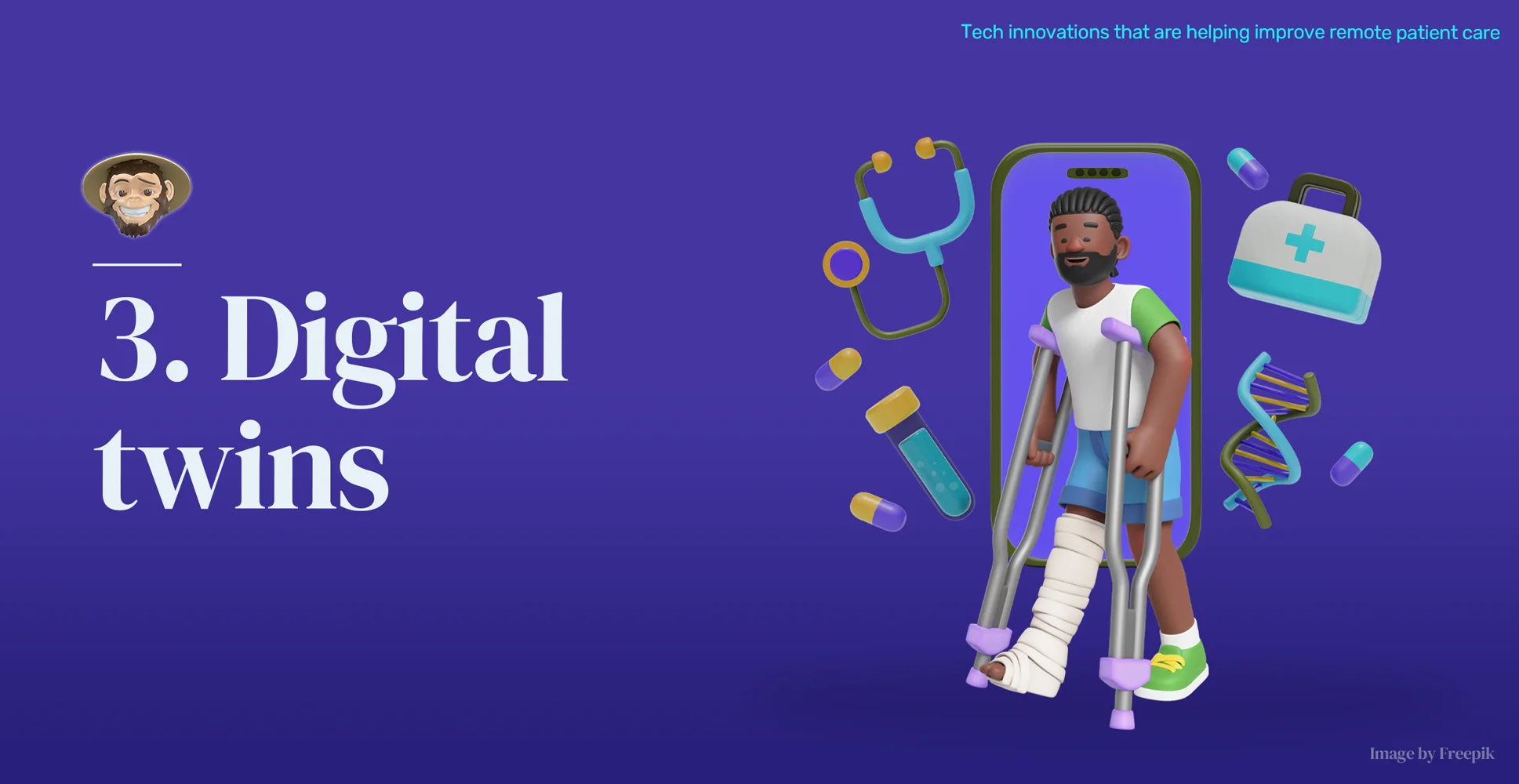
3. Digital twins
Yes, digital twins are being used in mobile healthcare and with great success. But in case you haven’t heard of digital twins, a digital twin is a virtual representation of a physical object, system, or process that goes way beyond being a simple digital clone of something or someone. So no, Whatsapp or Instagram personalized emojis don’t count as digital twins. The digital twins we are talking about and those that are helping improve remote patient care go beyond simple, static 3D models. They also integrate real-time data and other contextual information to create a dynamic, digital counterpart of the person or object they’re trying to mimic. The objective here is to deliver an entity that represents a physical entity as closely as possible in the digital realm, allowing for more efficient monitoring, analysis, and optimization. The global digital twin market size closed in 2022 at an estimated value of $11.13 billion and is projected to grow at a CAGR of 37.5% from 2023 to 2030.
In the remote healthcare arena, a digital twin refers to a high-fidelity virtual representation of a patient that uses real-time data to build a comprehensive and dynamic model that can drive decision-making processes. Digital twins are becoming increasingly valuable at enabling the continuous monitoring of patient’s vital signs, illness progression, and other health metrics using real-time data gathered via IoMT wearables, sensors, and other connected devices. This data is fed into each patient’s digital twin, which has already been created to mimic said patient’s physical and health characteristics, providing healthcare providers with up-to-the-minute information, simulations, and other actions without the need for in-person visits. Moreover, since digital twins include each patient’s genetics, lifestyle, and environmental factors, physicians can leverage this information to build personalized treatment plans, ensuring that interventions are tailored to the specific needs of each person.
For those reasons, and many more we won’t dive into today, digital twins are a technology that is quickly becoming groundbreaking in personalized and remote patient care. Although technology’s application in remote medical care is still developing, its potential is enormous. It promises to empower physicians to be proactive and understand, plan, conduct research, simulate, and gather valuable insights from patients without them physically being there.
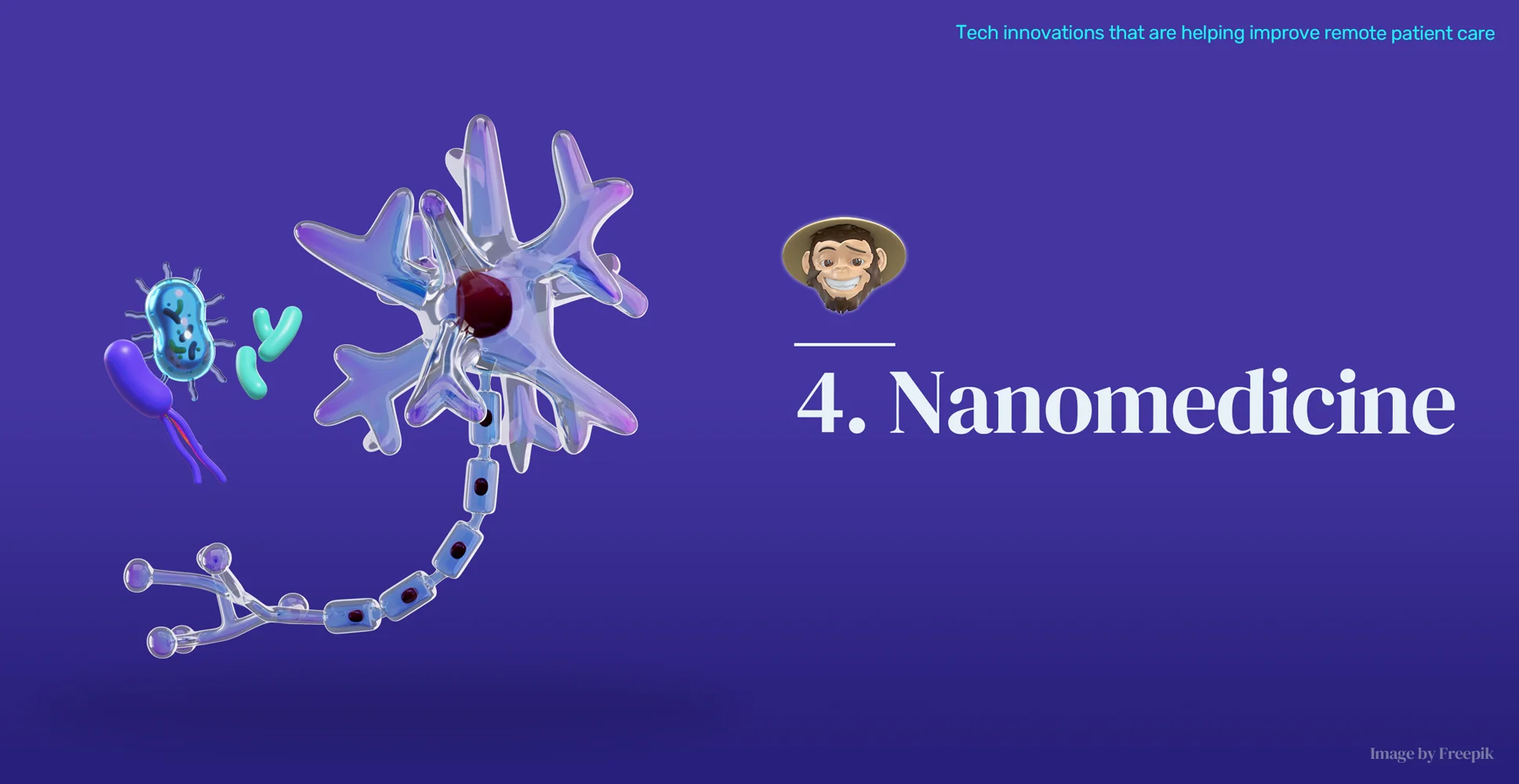
4. Nanomedicine
Nanomedicine is a field of medicine that leverages the benefits of nanotechnology for the diagnosis, treatment, and prevention of diseases. Nanomedicine relies on the use of elements, materials, and devices with dimensions on the nanoscale in order to enable interactions with biological molecules and structures at the molecular and cellular levels. As a result, nanomedicine can help physicians design and provide more targeted and efficient medical interventions that can cover additional ground in the realm of medicine delivery, imaging, disease prevention and treatment, regenerative medicine, therapy, personalized medicine, and remote medical care.
In remote patient care, nanomedicine holds the potential to revolutionize diagnostics, treatment, and monitoring of a myriad of health conditions and illnesses, especially chronic ones, which currently plague the lives of six of every ten Americans. For instance, physicians will be able to use nanosensors that are so inconceivably small that they can penetrate tissues and detect biomarkers associated with various diseases at the molecular level! What’s more, there are nanoparticles that can be programmed to carry certain medications directly to an ill patient’s cells or tissues, enhancing the efficacy of said medications and reducing side effects. In most remote healthcare settings, these nanomedicine-based particles and sensors could potentially deliver priceless insights because physicians could deploy them via healthcare applications and track their patient’s health condition in real-time and at a much deeper level than wearables, which can make early detection of conditions such as cancer or infectious diseases easier and significantly improve medical outcomes, save lives, and hopefully find cures.
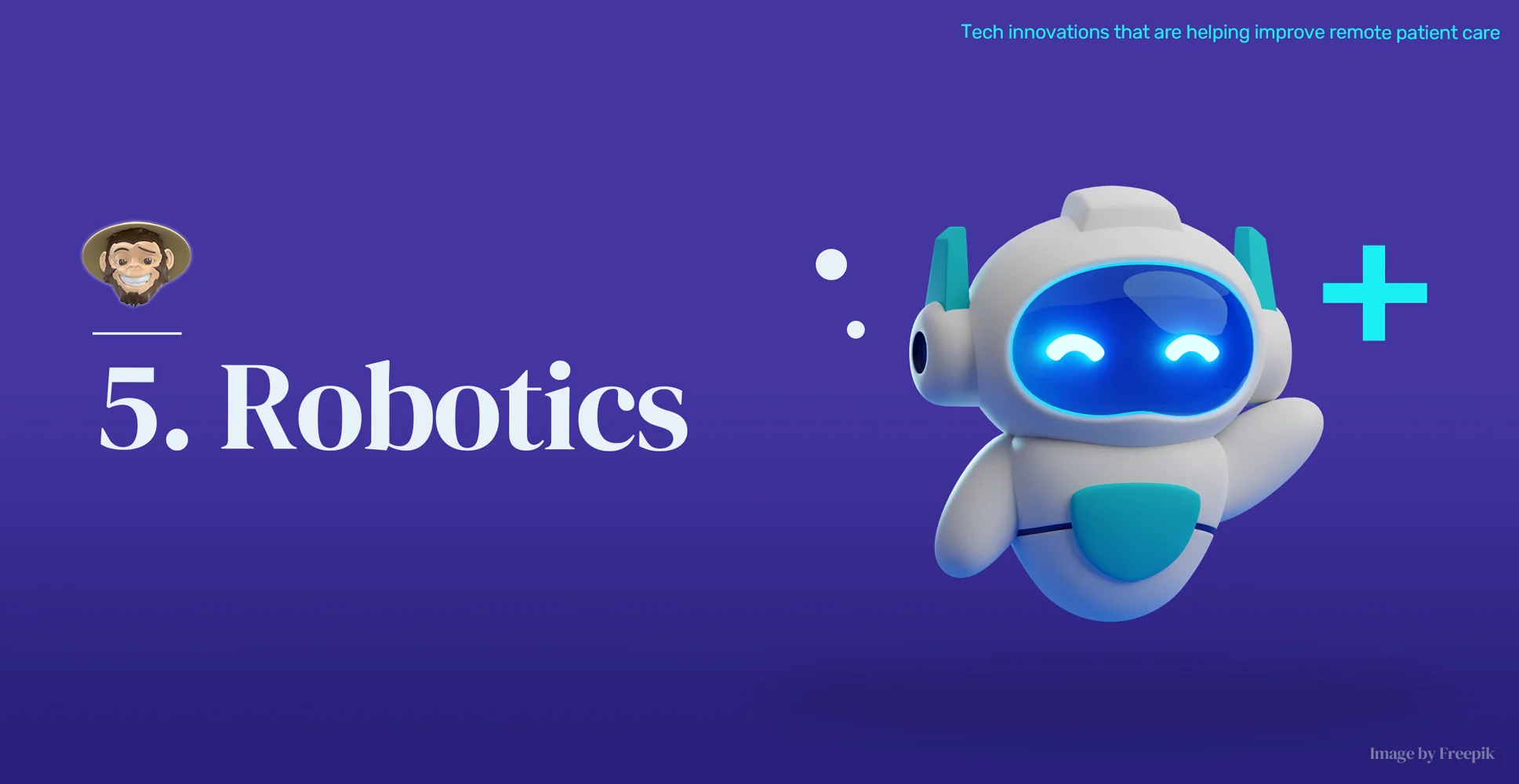
5. Robotics
We’ve already mentioned in previous blog articles that there is an escalating demand for remote healthcare services, which is partly due to an impending shortage of healthcare workers that has gotten more acute ever since the pandemic. Thankfully, a myriad of modern technologies are emerging as transformative forces to hopefully reshape remote medical practices and help solve current issues. One of those technologies is robotics, which is far from new or emerging but is evolving rapidly and has already started to play a pivotal role in providing very efficient remote healthcare solutions.
Robotics is the marriage between engineering, computer science, and artificial intelligence and focuses on the design, construction, operation, and use of robots. In the remote healthcare scenario, these robots can:
Promote telehealth: Telepresence robots can help healthcare professionals conduct remote consultations more efficiently, facilitating virtual patient visits and allowing physicians to assess their patients thoroughly, discuss symptoms, and provide medical guidance without needing in-person visits.
Automate diagnostics: Robotic sample analyzers can help build automated laboratories, helping streamline the process of sample testing and analysis, which is critical for timely and accurate remote diagnostics.
Enhance medicine delivery: Robots can be designed to deliver medications at precise intervals to help patients adhere to their prescribed drug regimens, enforcing medication adherence and helping improve outcomes.
Help in surgical procedures: Surgical robots, such as the da Vinci Surgical System, can help surgeons perform complex surgical procedures remotely, which is highly beneficial in scenarios where specialized surgical expertise may not be easily accessible or affordable.
Robotics promotes automation within the remote healthcare universe and represents a paradigm shift in how medical services are delivered. It has the potential to bridge gaps, promote positive outcomes, and enhance precision in diagnostics and treatment, all of which are at the forefront of reshaping the remote healthcare landscape.

Final word
Remote healthcare has become an increasingly relevant chapter in the book of global healthcare services. Since the COVID pandemic, it has become a pivotal avenue in the delivery of medical services because it makes healthcare services more accessible, efficient, and patient-centered, regardless of geographical distances. And with the help of some emerging technologies, remote healthcare is bound to undergo a transformation that will ensure that remote patient care becomes increasingly proactive, and accessible, remains inclusive and responsive to the evolving needs of patients worldwide, and morphs into a connected journey toward global healthcare coverage.
Here at Foonkie Monkey, we understand the importance of healthcare apps for remote patient care, and we always strive to build healthcare products that add value to users’ lives. So, if you have any questions regarding healthcare app development or want an experienced team like ours to work on your new app, get in touch! We’re more than happy to help.
